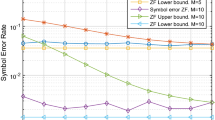Abstract
In this work, we propose Full Volterra and Sparse Volterra channels equalization algorithms for downlink LTE system. For estimation purpose, the LTE standard provides known data as pilot symbols and exploits them through a coherent detection to improve system performance. The references symbols location is similar to diamond pattern through time and frequency domain. Our goal is to show how to use the Full Volterra and Sparse Volterra equalizers over frequency domain in order to mitigate linear and nonlinear effects introduced by power amplifier and multipath channel. Downlink LTE Performances System in term of BLER, EVM (%) and Throughput versus SNR are presented and discussed. Then we compare our results with basic RLS equalizer curves. Moreover, it is shown that the Full Volterra and Sparse Volterra models can significantly reduce interferences and nonlinear effects and consequently improve the performances of LTE Downlink System.













Similar content being viewed by others
References
(2009). 3rd generation partnership project, technical specification group radio access network; evolved Universal terrestrial radio access (UTRA): Base station (BS) radio transmission and reception (pp. 22–33), TS 36.104, V8.7.0.
(2008). 3rd generation partnership project, evolved universal terrestrial radio access (E-UTRA); user equipment (UE) radio transmission and reception (pp. 22–33), ARIB STD-T63-36.101, V8.4.0.
Sesia, S., Toufik, I., & Baker, M. (2009). LTE: The UMTS long term evolution from theory to practice (1st ed.). Wiley: New York.
Technical White paper: “Long Term Evolution (LTE): A technical overview,” by Motorola. http://www.motorolasolutions.com/web/Business/Solutions/Industry%20Solutions/Service%20Providers/Wireless%20Operators/LTE/_Document/Static%20Files/6834_MotDoc_New.pdf.
Simko, M., Wu, D., Mehlfuhrer, C., Eilert, J., & Liu, D. (2011). Implementation aspects of channel estimation for 3GPP LTE terminals. In Proceedings of the European Wireless 2011, Vienna, April.
Ancora, A., Bona, C., & Slock, D. T. M. (2007). Down-sampled impulse response least-squares channel estimation for LTE OFDMA, in 2007. In IEEE International Conference on Acoustics, Speech and Signal Processing, (ICASSP’2007) April 2007, (Vol. 3, pp. III-293–III-296).
Omar, S., Ancora, A., & Slock, D. T. M. (2008). Performance analysis of general pilot-aided linear channel estimation in LTE OFDMA systems with application to simplified MMSE schemes. In Proceedings of IEEE (PIMRC’2008), Cannes, French Riviera, France, September (pp. 1–6)
3rd Generation Partnership Project, Technical Specification Group Radio Access Network; evolved Universal Terrestrial Radio Access (UTRA): Physical channels and modulation layer (pp. 55–67), TS 36.211, V8.8.0, 2009.
Le, L. I. U., Hamaguchi, K., & Wakana, H. (2005). Analysis of the combined effects of nonlinear distortion and phase noise on OFDM systems. IEICE Transactions on Communications, E88-B(1), 304.
Costa, E., & Pupolin, S. (2002). M-QAM-OFDM system performance in the presence of a nonlinear amplifier and phase noise. IEEE Transactions on Communications, 50, 462–472.
Therrien, C. W., Jenkins, W. K., & Xiaohui, L. (1999). Optimizing the performance of polynomial adaptive filters: Making quadratic filters converge like linear filters. IEEE Transactions on Signal Processing, 47(4), 1169.
Haykin, S. (1996). Adaptive filter theory. New Jersey: Prentice-Hall.
Kibangou, A., & Favier, G. (2007). Blind joint identification and equalization of Wiener–Hammerstein communication channels using Paratuck-2 tensor decomposition. In 15th European Signal Processing Conference (EUSIPCO’2007), Poznan, Poland (pp. 1516–1520) September 2007.
Nasreddine, M., Bechir, N., Hakimi, W., & Ammar, M. (2014). Channel estimation for downlink LTE system based on LAGRANGE polynomial interpolation. In The Tenth International Conference on Wireless and Mobile Communications from June 22, 2014 to June 26, 2014.
In-seung Park, B. S. (1994). Design of equalizers for nonlinear digital communication systems using volterra filtering techniques. Master thesis, The University of Texas at Austin.
Korenbergan, M. J., & Paarmann, L. D. (1991). Orthogonal approaches to time series analysis and system identification. IEEE Signal Processing Magazine, 8(3), 29–43.
Reis, J. D., Costa, L. N., & Teixeira, A. L. (2010). Nonlinear effects pre-diction in ultra-dense WDM systems using volterra series. In Proceedings of the Optical Fiber Communication Conference Collocated National Fiber Optic Engineers Conference (pp. 1–3) March 21–25.
Gander, W. Algorithms for the QR-decomposition, research report, 80–82 (p. 127) [Online]. http://www.inf.ethz.ch/personal/gander/papers/qrneu.pdf.
Author information
Authors and Affiliations
Corresponding author
Rights and permissions
About this article
Cite this article
Mallouki, N., Nsiri, B., Mhatli, . et al. Analysis of Full Volterra and Sparse Volterra Nonlinear Equalization for Downlink LTE System. Wireless Pers Commun 89, 1413–1432 (2016). https://doi.org/10.1007/s11277-016-3325-6
Published:
Issue Date:
DOI: https://doi.org/10.1007/s11277-016-3325-6




